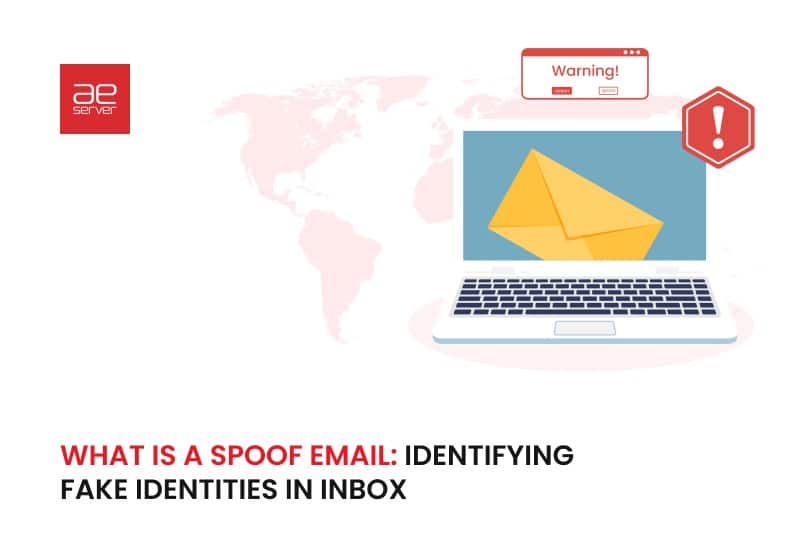
Understanding What Is a Spoof Email
Unfortunately, thieves exist not only in real life. They also roam the Internet, where they carry out cyberattacks. One type of such attack is spoofing. In short, this is an email spoofing.
Spoof email is when criminals counterfeit an email address. They try to look like the actual sender. They give out the email address as one thing, but something criminal hides behind it. For example, there are situations when people receive an email from a goverment or a bank. Everything looks as real as possible, which gives you confidence. But as soon as you follow the link, you can lose your critical personal data. It’s what a spoof email is. It is a sophisticated deception where the scammers are pretending to be someone they are not. The primary purpose is to gain access to your confidential information and money or even spread malware on your computer.
Unfortunately, more and more fake emails are spreading. And many people become victims of such deception. In such situations, it is important to be able to protect yourself.
Unraveling the Concept of Spoof Emails
Exposing the concept of fake emails is an integral part of the fight against cybercrime. This problem has become especially relevant in recent years. Criminals have begun to use increasingly innovative technologies to bypass spam protection. This concept is also known as “phishing.” It has become a complex action affecting the digital world’s most critical points. If earlier people could see that it’s a spoof email, now it is more difficult. After all, swindlers hide such things behind an illusion. They try to gain your trust and get what they want. And many do not suspect anything about it.
How does email spoofing work?
For this, scammers use social engineering.
Spoofing can be applied to many communication channels. To be successful, a spoofing attack should involve some level of social engineering. It means that the methods used by fraudsters can effectively trick their victims into giving up their personal information. They use high skills. It is to play on human characteristics such as greed, fear, and naivety.
Fake emails can take many forms. It ranges from the imitation of famous companies to the simulation of a work colleague. They aim to convince you to provide personal information, passwords, and financial data. As soon as a person falls for their hook, scammers get what they want.
To avoid such problems, it is crucial to use email spoofing prevention. It is necessary to understand the main features of phishing emails. Pay attention to unusual sender addresses, spelling mistakes, and suspicious links. Remember that official resources never ask for personal information or passwords via email. Also, you won’t be forced to do any strange things in real emails. By such signs, you can easier detect the deception.
How Does Email Spoofing Work?
So now, let’s dive into creating fake emails in detail. After all, this is a whole science that requires specific skills. Cybercriminals do it so well that it does not cause any suspicion. So, how does email spoofing work? Here’s a step-by-step plan for it:
- Target selection. The attacker chooses the target. It can be a certain person, company, or organization.
- Defining the Scenario. Next, the attacker develops a detailed cyber attack plan. They create a strategy of how and when to attract a victim. And they also think about the best way to draw the recipient to their trap. It can be, for example, a need to update account data.
- Preparation of the Letter. Next, they create a fake letter. It can include counterfeited email addresses, domain names, and other details.
- Fake Link. The attacker does a link that looks official. But they actually redirect to a fake site.
- Creating Interest. For the victim to fall for the spoof email, scammers make it as attractive as possible. It may contain a need for immediate action or a warning about potential danger.
- Sending a letter. When everything is ready, the attackers send a fake letter to the victim. And immediately after that, they cover their tracks. To do this, they can use network tunnels to redirect traffic.
Identifying a Spoof Email
Email is an important communication channel in today’s world. But fake messages can harm both individuals and businesses. So, it is imperative to resist it and protect yourself. Knowing what is a spoof email and detecting it is sometimes a complex process. But spotting it is an excellent skill. Thanks to this, you can recognize invalid or counterfeit emails. Then you are not afraid of any threats from fraudsters. So, here are several ways to know that you are facing a phishing email:
| The sender’s domain | One of the most common methods of detecting fake emails is to check the sender’s domain. Spoof emails often have a domain that is different from the official one. But they look almost identical. What signs state that this is a fake email message? Usually, in fake domains, the letters’ size and punctuation may differ slightly. For example, official: “abc.com,” and fake: ”abc-inc.com.” |
| Illiteracy | An extra sign of a fake email can be malformed message formatting. Phishing emails may contain grammatical and spelling mistakes. And this is the biggest thing that betrays cyber attackers. After all, official sources of email distribution always adhere to literacy. |
| Information about the organization | Check if you can verify your organization details. Scammers can make up company names or use existing ones. Go directly to the official website to check the information. |
Remember that detecting a fake email is not just a duty. It’s a key tool for protecting your finances, personal data, and digital security. Do not remain indifferent, but be attentive and careful. And always check what others send to you.

Email Spoofing Prevention
Many emails are sent every day in the virtual world. Each of them has its purpose and message. But can you confidently say that every message in mailboxes is true and valid? No. Why? Because the people behind cyberattacks continue their work every day. They send phishing emails to a large number of people looking for victims. So, not all letters that roam the Internet daily are valid and official.
What to do in situations when you come across counterfeit emails? In this case, it is crucial to ensure email spoofing prevention. It involves a comprehensive approach. It includes using cryptographic methods to ensure the integrity and authenticity of messages. And this also consists of the use of validation and filtering systems. They help identify suspicious or fake news.
Also, there are a few rules to follow to prevent email spoofing. Above all, do not open emails from unfamiliar or suspicious addresses. And for essential emails, always use email encryption tools. Do you want to know more effective tips about it? Keep reading:
Encrypt emails
Encrypting emails is one of the most effective ways to prevent spoof emails. This process ensures the confidentiality and integrity of information. After all, this is the process of converting the plain text of an email into an incomprehensible code. It allows you to provide the privacy and security of your mail.
You can implement encryption using different methods. Among them is the use of cryptographic protocols and public keys. It means that even if someone gets access to your mail, they will not be able to read the content of the emails without you. Thus, encryption is the best way to make emails inaccessible to prying eyes.
Install SPF
SPF is another effective tool for email spoofing prevention. It will make your email more authentic. Accordingly, this will reduce the probability of receiving spoof emails.
Sender Policy Framework, or SPF, is a real defender of your address against fake emails. This method is based on the instructions you give to email servers. You tell the servers which IP addresses can send emails from your domain and which are not. It means that only authorized servers can send emails on behalf of your domain. SPF helps avoid attackers sending counterfeiting to you. It ensures the security and authenticity of your email.
Use an anti-malware tool
One of the easiest ways to protect your address from spoof emails is to use antivirus software. These programs help detect and block potentially dangerous messages containing spoof emails. They analyze each message for malicious files or links. And if they see a threat, they automatically block such messages. But it is important to update your antivirus software regularly. It is to have the latest updates that include new methods to detect spoof emails.
So, antivirus programs are your faithful assistants in the fight against malicious programs and spam. They don’t just scan your inbox and outbox for threats. They also analyze suspicious acts around your mail. The main thing is to choose a reliable and updated antivirus solution.
Deploy an email security gateway
This method filters incoming email messages and checks them for phishing emails. It uses different methods of analysis. It includes the sender’s IP address, domain verification, and SPF signature verification. The electronic security gateway can detect unusual situations in your email. And this may say an attempt at spoofing. Accordingly, this is how you can find out about suspicious actions on the part of criminals.
With a secure email gateway, you can set up a filter to block emails from specific IP addresses. It can also prevent third-party access to your email. In this way, you do not fall into the trap of cyber attackers.
Update passwords regularly
Another critical step is to change the passwords on your email account regularly. Hackers usually gain access to important data through password discovery. If you have the same password for a long time and it’s easy, you can become a victim of phishing emails. After all, it is not a very difficult task for cyber attackers to find out your password. But you can make it difficult for them by changing it often.
You can choose a strong password and change it weekly or monthly. Use complex symbols, words, and numbers. Combine letters and special characters. Then it is unlikely that someone will be able to use your email against you.
Bottom Line
The digital world is rich in traps where frauds await victims. And one of the most critical deceptions in it is spoofing emails. As soon as you click on a fake link, you can make one of the biggest mistakes. After all, this way, you can give scammers your secret information, passwords, and money. Thus, knowledge of email spoofing prevention is critical.
Wait to follow the link that you received on your device. Read it in detail, check domain, but don’t click. If there is something suspicious and a completely inappropriate for you, ignore it. Delete such an email immediately. Then you can protect yourself from the serious consequences of this.
Frequently Asked Question
-
Can spoof emails be blocked by email providers?
Yes, email providers use a multi-layered approach to protect against spoofed emails. It includes a combination of authentication protocols, content analysis, and behavioral analytics. By implementing many layers of defense, email providers create a formidable barrier. It significantly reduces the chances of spoofed emails bypassing their safeguards.
-
What should I do if I receive a suspicious email?
If you receive an email that appears suspicious or unfamiliar, it’s best not to open it. Instead, promptly delete it from your inbox. Cybercriminals often use urgent messages to lure recipients into opening these emails. Deleting the email ensures you avoid any potential risks associated with cyberattack.
-
Can email security software help prevent spoof emails?
Absolutely. The email security software acts as a powerful shield against spoof emails. Through advanced filtering, it can accurately differentiate between authentic and fraudulent emails. This way, it protects you from potential risks.
-
What other email-related threats should I be aware of?
Apart from spoofing, phishing attacks are a significant threat. Cybercriminals create convincing emails or messages to trick you into revealing sensitive information. It can be your passwords or credit card details.



